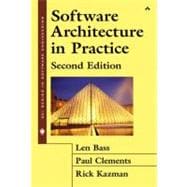
I. ENVISIONING ARCHITECTURE.
1. The Architecture Business Cycle.II. CREATING AN ARCHITECTURE.
4. Understanding Quality Attributes.III. ANALYZING AN ARCHITECTURE.
11. The ATAM: A Comprehensive Method for Architecture Evaluation.IV. MOVING FROM ONE SYSTEM TO MANY.
14. Software Product Lines: Reusing Architectural Assets.The New copy of this book will include any supplemental materials advertised. Please check the title of the book to determine if it should include any access cards, study guides, lab manuals, CDs, etc.
The Used, Rental and eBook copies of this book are not guaranteed to include any supplemental materials. Typically, only the book itself is included. This is true even if the title states it includes any access cards, study guides, lab manuals, CDs, etc.